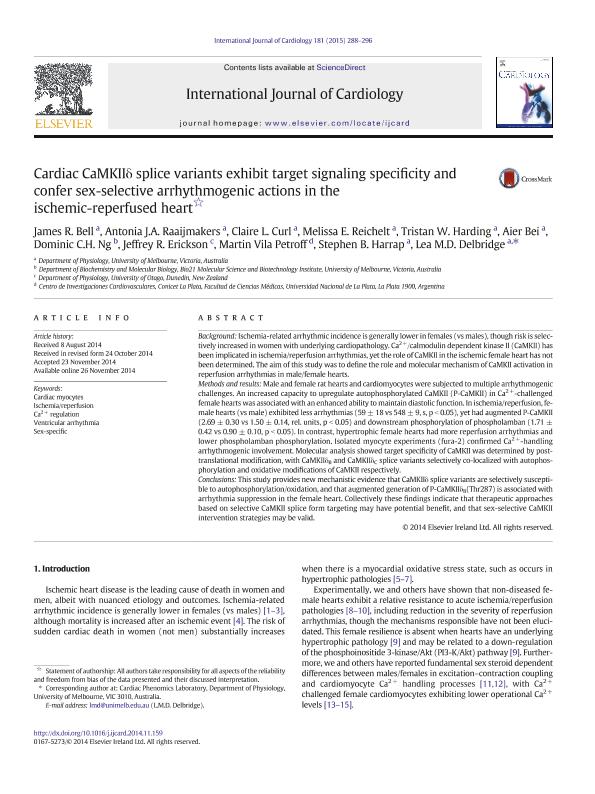Mostrar el registro sencillo del ítem
dc.contributor.author
Bell, James R.
dc.contributor.author
Raaijmakers, Antonia J.A.
dc.contributor.author
Curl, Claire L.
dc.contributor.author
Reichelt, Melissa E.
dc.contributor.author
Harding, Tristan W.
dc.contributor.author
Bei, Aier
dc.contributor.author
Ng, Dominic C.H.
dc.contributor.author
Erickson, Jeffrey R.
dc.contributor.author
Vila Petroff, Martin Gerarde

dc.contributor.author
Harrap, Stephen B.
dc.contributor.author
Delbridge, Lea M.D.
dc.date.available
2017-01-26T20:16:54Z
dc.date.issued
2015-02
dc.identifier.citation
Bell, James R.; Raaijmakers, Antonia J.A.; Curl, Claire L.; Reichelt, Melissa E.; Harding, Tristan W.; et al.; Cardiac CaMKIIδ splice variants exhibit target signaling specificity and confer sex-selective arrhythmogenic actions in the ischemic-reperfused heart; Elsevier Ireland; International Journal Of Cardiology; 181; 2-2015; 288-296
dc.identifier.issn
0167-5273
dc.identifier.uri
http://hdl.handle.net/11336/12023
dc.description.abstract
BACKGROUND: Ischemia-related arrhythmic incidence is generally lower in females (vs males), though risk is selectively increased in women with underlying cardiopathology. Ca(2+)/calmodulin dependent kinase II (CaMKII) has been implicated in ischemia/reperfusion arrhythmias, yet the role of CaMKII in the ischemic female heart has not been determined. The aim of this study was to define the role and molecular mechanism of CaMKII activation in reperfusion arrhythmias in male/female hearts.
METHODS AND RESULTS: Male and female rat hearts and cardiomyocytes were subjected to multiple arrhythmogenic challenges. An increased capacity to upregulate autophosphorylated CaMKII (P-CaMKII) in Ca(2+)-challenged female hearts was associated with an enhanced ability to maintain diastolic function. In ischemia/reperfusion, female hearts (vs male) exhibited less arrhythmias (59 ± 18 vs 548 ± 9, s, p<0.05), yet had augmented P-CaMKII (2.69 ± 0.30 vs 1.50 ± 0.14, rel. units, p<0.05) and downstream phosphorylation of phospholamban (1.71 ± 0.42 vs 0.90 ± 0.10, p<0.05). In contrast, hypertrophic female hearts had more reperfusion arrhythmias and lower phospholamban phosphorylation. Isolated myocyte experiments (fura-2) confirmed Ca(2+)-handling arrhythmogenic involvement. Molecular analysis showed target specificity of CaMKII was determined by post-translational modification, with CaMKIIδB and CaMKIIδC splice variants selectively co-localized with autophosphorylation and oxidative modifications of CaMKII respectively.
CONCLUSIONS: This study provides new mechanistic evidence that CaMKIIδ splice variants are selectively susceptible to autophosphorylation/oxidation, and that augmented generation of P-CaMKIIδB(Thr287) is associated with arrhythmia suppression in the female heart. Collectively these findings indicate that therapeutic approaches based on selective CaMKII splice form targeting may have potential benefit, and that sex-selective CaMKII intervention strategies may be valid.
dc.format
application/pdf
dc.language.iso
eng
dc.publisher
Elsevier Ireland

dc.rights
info:eu-repo/semantics/openAccess
dc.rights.uri
https://creativecommons.org/licenses/by-nc-nd/2.5/ar/
dc.subject
Ca(2+) Regulation
dc.subject
Cardiac Myocytes
dc.subject
Ischemia/Reperfusion
dc.subject
Sex-Specific
dc.subject
Ventricular Arrhythmia
dc.subject.classification
Fisiología

dc.subject.classification
Medicina Básica

dc.subject.classification
CIENCIAS MÉDICAS Y DE LA SALUD

dc.title
Cardiac CaMKIIδ splice variants exhibit target signaling specificity and confer sex-selective arrhythmogenic actions in the ischemic-reperfused heart
dc.type
info:eu-repo/semantics/article
dc.type
info:ar-repo/semantics/artículo
dc.type
info:eu-repo/semantics/publishedVersion
dc.date.updated
2017-01-25T13:57:51Z
dc.journal.volume
181
dc.journal.pagination
288-296
dc.journal.pais
Irlanda

dc.description.fil
Fil: Bell, James R.. The University Of Melbourne; Australia
dc.description.fil
Fil: Raaijmakers, Antonia J.A.. The University Of Melbourne; Australia
dc.description.fil
Fil: Curl, Claire L.. The University Of Melbourne; Australia
dc.description.fil
Fil: Reichelt, Melissa E.. The University Of Melbourne; Australia
dc.description.fil
Fil: Harding, Tristan W.. The University Of Melbourne; Australia
dc.description.fil
Fil: Bei, Aier. The University Of Melbourne; Australia
dc.description.fil
Fil: Ng, Dominic C.H.. The University Of Melbourne; Australia
dc.description.fil
Fil: Erickson, Jeffrey R.. University Of Otago; Nueva Zelanda
dc.description.fil
Fil: Vila Petroff, Martin Gerarde. Consejo Nacional de Investigaciones Cientificas y Tecnicas. Centro Cientifico Tecnológico la Plata. Centro de Investigaciones Cardiovasculares "Dr. Horacio Eugenio Cingolani"; Argentina. Universidad Nacional de la Plata. Facultad de Ciencias Médicas; Argentina
dc.description.fil
Fil: Harrap, Stephen B.. The University Of Melbourne; Australia
dc.description.fil
Fil: Delbridge, Lea M.D.. The University Of Melbourne; Australia
dc.journal.title
International Journal Of Cardiology

dc.relation.alternativeid
info:eu-repo/semantics/altIdentifier/doi/http://dx.doi.org/10.1016/j.ijcard.2014.11.159
dc.relation.alternativeid
info:eu-repo/semantics/altIdentifier/url/http://www.sciencedirect.com/science/article/pii/S0167527314023407
Archivos asociados
